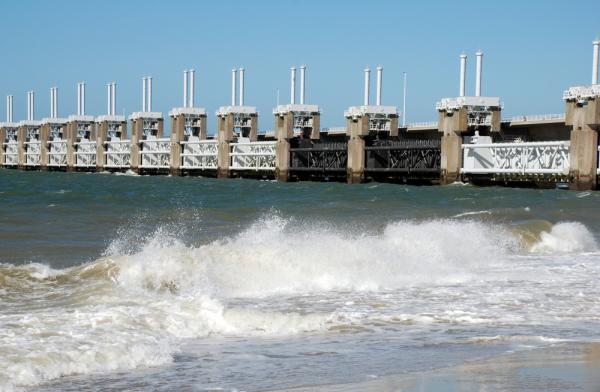The news reports, like personal possessions that eventually emerge from roaring whitewater upstream, keep surfacing. They're coming from the bayous of the continental southeast to the northlands of Alaska. The nation's coastal waters are rising, towns dating back centuries are at serious risk of being engulfed and disappearing completely, and there's little indication that the problem will somehow, simply correct itself.
So what should the United States be doing to address this cascading calamity? More engagement and continued dialogue with the Dutch might be a good place to start. Officials from the Netherlands are experts in flood mitigation, given that roughly 60 percent its country's land lies below sea level and two thirds of the nation's citizens live in flood-prone districts. So if anyone knows about the importance of flood prevention, it's the Dutch. But as for now, instead of prevention, we're seeing recent cases of American towns and enclaves being abandoned, because it's too late to rescue them from rising ocean levels.
In January, the decision was made to relocate the Louisiana town of Isle de Jean Charles, located southwest of New Orleans on the Gulf of Mexico. And the act is noteworthy in that it's the first time federal tax dollars are being spent to move a community, instead of protect it. The Department of Housing and Urban Development gave the town, which has nearly completely disappeared, $48 million to pull up stakes and move to higher and drier ground. It has until 2022 to spend the relocation funds.
Flood waters engulfing a U.S. town
"Since 1955, the Isle de Jean Charles band of the Biloxi-Chitimacha-Choctaw tribe has lost 98 percent of its land to the encroaching Gulf waters. Of the 22,400-acre island that stood at that time, only a 320-acre strip remains. The tribe’s identity, food, and culture have slowly eroded with the land," National Geographic reported. " 'We don’t have time,' tribal chief Albert Naquin, who spent the last 15 years advocating to relocate his people, said. 'The longer we wait, the more hurricane season we have to go through. We hate to let the island go, but we have to. It is like losing a family member. We know we are going to lose it. We just don’t know when.' ”
And more recently, Alaskan villagers on an island north of the Bering Strait voted earlier this month to leave their town of Shishmaref, in favor of a mainland location about five miles away. "It has been grappling for decades with the loss of buildings and infrastructure caused by storm surges, and it has shrunk over the past 40 years — more than 200 feet of the shore has been eaten away since 1969," according to the New York Times. "But the village needs an estimated $180 million from a patchwork of sources to complete the move, according to a 2004 estimate."
The Dutch, however, have addressed problems like this. For instance, there's the innovative storm-surge barrier installed just before the turn of the century in Rotterdam, a port city. Known as the Maeslantkering, it's described as a "giant drawbridge toppled sideways," with pontoon gates that can be filled with water to make them stronger, making it "one of the largest moving structures on the planet." In addition, the Dutch have also mastered seawall production, and "scientists also have developed a cloud-based software app that enables them to model flooding risks for an area in 3D."
But for American officials to take advantage of these flood-prevention concepts, they first must adapt to a new (e.g. Dutch) way of addressing rising waters, which FEMA has learned through a commissioned report in 2013 that "the risk of floods across the United States will increase by 45 percent over the rest of this century." And according to a 2012 Times report, that means getting ahead of the problem.
"The Dutch 'way of thinking is completely different from the U.S.,' where disaster relief generally takes precedence over disaster avoidance, said Wim Kuijken, the Dutch government’s senior official for overall water control policy. 'The U.S. is excellent at disaster management,' but 'working to avoid disaster is completely different from working after a disaster.' ”





